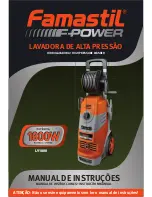
HOTSY 680SS • 8.914-368.0 • Rev. 02/15
OPERATOR’S MANUAL
PRESSURE WASHER
8
Figure 2 - Pressure Hose Installation
Relief
Valve
Pressure
Hose
ASSEMBLY INSTRUCTIONS
Unpacking
Unpack carefully. Wear safety glasses or goggles while
unpacking, assembling or operating pressure washer.
If there are missing components or hidden damage
immediately contact distributor or carrier concerning
discrepancies.
1. Cut strapping band from pressure washer and pal-
let.
2. Remove pressure washer from pallet.
Parts Included
•
Pressure Washer
•
Pressure Hose
•
Hose Hanger
•
Wand
•
Wheels (4 Ea.)
•
Axles (2 Ea.)
•
Handle
•
Parts Bag Containing:
■
Bolts 5/16" x 1-1/2" (5 Ea.)
■
Vinyl Cap
■
Nuts 5/16" (5 Ea.)
■
Washers 5/8" (10 Ea.)
■
Pressure Nozzle
■
Hubcaps (4 Ea.)
■
Spring Washers (4 Ea.)
■
Quick Disconnect
■
Quick Disconnect Plug
■
Trigger Gun
■
GFCI Cord Hanger
•
Operating Instructions and Parts Manual
Tools Required
•
10" Adjustable Crescent Wrenches (2 Ea.)
•
11/16" Socket
•
Hammer
•
7/16" Open End Wrench
•
Tefl on Tape
Pressure Hose and Wand
1. When assembling, use tefl on tape on all plumbing
connections to prevent leakage.
2. Install pressure hose on machine as shown in
Figure 2.
IMPORTANT: Before installing pressure hose onto the
trigger gun/wand assembly, turn on the water supply
and allow water to run from the end of the hose until
clear to prevent the nozzle from clogging.
3. Assemble wand components as shown in
Figure 3
.
Connect pressure hose to trigger gun.
4. Make sure that all plumbing connections are tight.
Figure 3 - Wand Components
Quick Disconnect
Plug
Quick Disconnect
Wand
Nozzle
Trigger
Gun
Pressure Hose
INSTALLATION
INSTRUCTIONS
Getting Started
IMPORTANT: Proper initial installation of equipment
will assure more satisfactory performance, longer
service life, and lower maintenance cost.
IMPORTANT: The use of a back
fl
ow preventer on the
water supply hose is recommended and may be re-
quired by local code.
The pressure washer should be run on a level surface
and in a protected area where it is not readily infl uenced
by outside forces such as strong winds, freezing
temperatures, rain, etc. The pressure washer should
be located to assure easy access for fi lling of fl uids,
adjustments and maintenance. Normal precautions should
be taken by the operator to prevent moisture from reaching
the pressure washer. It is recommended that a partition be
made between the wash area and the pressure washer
to prevent direct spray from the wand from coming in
contact with the pressure washer. Moisture reaching the
equipment will reduce the pressure washer’s service life.
All installations must comply with the local codes covering
such installations.








































